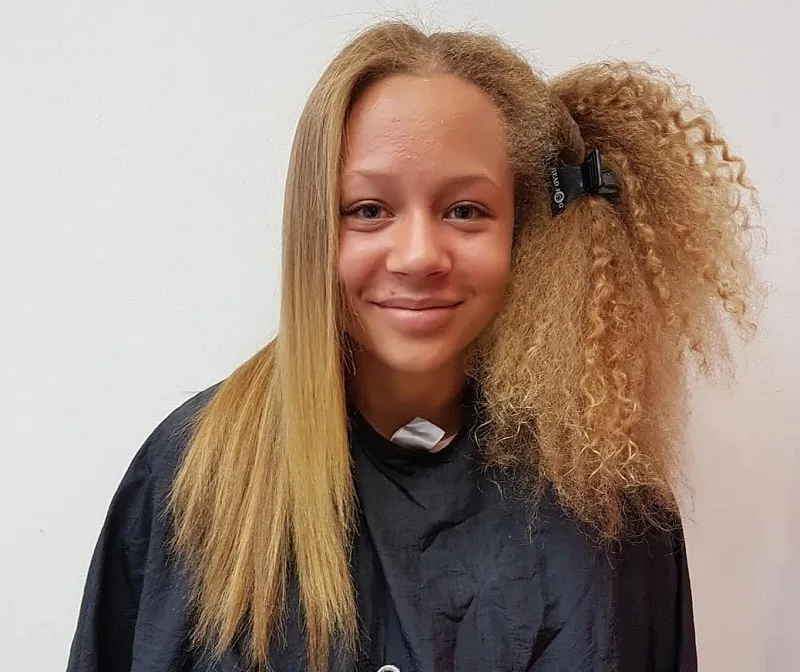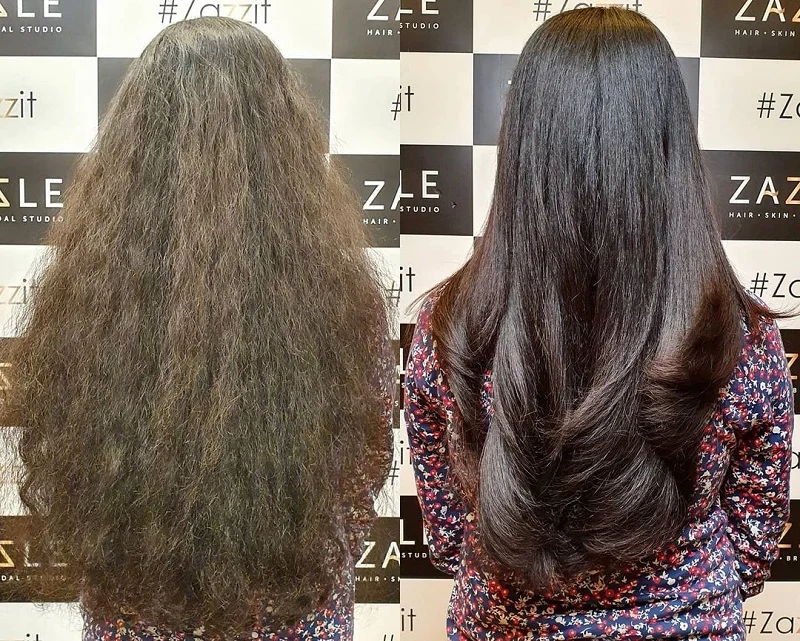Whether or not to straighten your hair is an important decision. Most beauty salons offer several ways to achieve permanent and semi-permanent straight hair.
Two of the most popular ways to get permanent or long-lasting straight hair are the Japanese hair straightening method and the Brazilian blowout method.
However, when making these dramatic chemical changes to your natural hair, you need to choose one that is reliable and suits you and your look.
Each of these methods has its advantages. We will analyze both Japanese hair straightening and Brazilian blowout to determine which is the best overall hair straightening treatment.
Japanese hair straightening

Japanese hair straightening, also known as “thermal reconditioning,” began in Japan in the 1990s. Created by stylist and brand founder Yuko Yamashita. Yuuko.
The process involves a chemical treatment that destroys the hair’s natural structure, followed by the application of heat to rebuild the hair, resulting in permanently straight hair.
Women kept coming to her salon complaining about how unruly their hair was and how difficult it was to control. That’s why Yuko has developed a system that can permanently straighten your wavy, coarse, or curly hair.
What can be solved with Japanese hair straightening 70% to 90% of curl/frizz. Having Japanese hair straightened at a professional salon will cost between $450 and $800.
This is typically based on an hourly rate for the entire process, which takes approximately 5 hours. Once the treatment is complete, your hair will remain straight for up to 6 months.
Japanese hair straightening process:
First, apply a solution to your hair to break the molecular bonds and make your hair softer and straighter.
The stylist then rinses and blow-dries your hair before ironing it to ensure the chemical process is tightly locked in.
A neutralizing agent is then added to restore molecular bonds and pH levels. Rinse again, blow dry, and iron for permanently straight hair.
Advantages and disadvantages of Japanese hair straightening

It is important to consider the pros and cons before deciding whether to undergo Japanese hair straightening. Now, let’s take a look at the advantages and disadvantages.
Strong Points:
- One of its biggest advantages is its permanence. Your hair will remain straight until it grows out. Makes hair more manageable, especially for those with curly, curly, or curly hair.
- It produces a very smooth, smooth, and glossy finish that is often difficult to achieve with other straightening methods.
- Once you treat your hair, your daily styling time will be significantly reduced. You don’t have to spend a lot of time blowdrying or straightening your hair.
- Effective on a variety of hair types, including very curly and coarse hair.
Cons:
- The chemicals and heat used in this process can cause significant damage, especially to already weakened hair or hair that has been previously chemically treated.
- Since it is a permanent treatment, it is difficult to reverse it if you are wrong or dissatisfied with the results. Straightening your hair prevents you from creating styles that require natural curls or waves.
- As new hair grows, it retains its natural texture. Therefore, regular touch-ups are required.
- This process is expensive and time-consuming, often taking several hours at a salon.
- Not recommended for people with severely damaged hair or hair that has been overly processed with other chemicals.
brazilian blowout
A Brazilian blowout is a hair smoothing treatment used to reduce frizz and improve hair shine. This hair straightening method has been popular since the early 1980s.
Riviero Paulo kathy ireland A (famous supermodel) hairstylist invented this process in Aguas de Lindoia, Brazil. He created it to keep models’ hair straight during week-long photo shoots.
This method was considered innovative because it does not leave any lines and looks more natural. It also prevents border separation (when curly hair regrows and mixes with straight hair).
The Brazilian Blowout is extremely popular in New York and Los Angeles because it is practical and quick to apply.
Generally, Brazilian blast lasts 10-12 weeks and takes 45 minutes to apply. In a professional salon, it will cost between $200 and $500.
Brazilian blowout process:
This treatment is based on liquid keratin, which is used in most hair straightening treatments. Adheres to hair and coats it to protect it from damage.
After removing the keratin, blow dry your hair, condition it, rinse it, and blow dry it again.
The heat from the iron activates the bonds between the chemicals and your hair.
This process is native to Brazil, so it requires several ingredients found within the country. Brazilian blowout liquid also contains camu camu, acai berry, and annatto seeds.
Using acai berry as a maintenance product will help your pimples last longer. Depending on how long your stylist is ironing your hair, the straightness can vary from slightly to completely straight.
Pros and cons of Brazil’s explosion

A Brazilian blowout is a popular hair smoothing treatment, but like any hair straightening procedure, it has its pros and cons.
Strong Points:
- Effectively reduce frizz and make hair smoother, shiny and manageable.
- It is effective on various hair types, including curly hair, curly hair, and terminal hair.
- Styling your hair after treatment becomes easier and faster. Blow drying and straightening your hair will take much less time.
- Unlike some treatments, you don’t have to wait several days before washing your hair and styling it the way you like.
- Treatments can be tailored to remove frizz while maintaining your natural texture or achieve a smoother, straighter look.
- Improves the appearance of damaged hair, adding healthy shine and smoothness.
Cons:
- Brazilian blowout contains chemicals such as formaldehyde (or formaldehyde-releasing ingredients), which can be harmful and can emit potentially toxic fumes during processing.
- Results usually last about 3-4 months, depending on hair type and maintenance. Regular treatments are required to maintain the appearance.
- Prices vary depending on the salon, hair length and thickness, and can be expensive.
- Although it can make your hair look healthier, the chemicals and heat used in the process can damage your hair.
- Due to the chemicals used, it is not recommended for people with severely damaged hair or for pregnant or breastfeeding women.
- To maintain the effectiveness of the treatment, certain sulfate-free hair care products are recommended, but this can increase the overall cost.
Japanese hair straightening vs. Brazilian blowout
Now that you understand how both processes work, let’s take a look at the differences between a Brazilian blowout and Japanese hair straightening.
nature of results
The chemical reaction during Japanese hair straightening is powerful and can keep your hair straight for several months.
Brazilian blowouts are effective and make hair more manageable, but they don’t last as long as the Japanese method.
Manageability
If you love keeping your hair straight and are tired of going to the salon or spending hours doing it yourself, Japanese hair straightening may be the method for you.
The long-lasting treatment allows you to focus your time on other areas of your body to keep it looking great after a quick morning brushing.
Hair texture after treatment
Japanese hair straightening permanently straightens your hair. This process is designed to completely remove curls and waves and provide a consistent, straight look.
A Brazilian blowout leaves your hair soft and smooth while preserving some of its natural texture and volume. It’s less about achieving straight hair and more about reducing frizz and improving manageability.
chemical strength
Japanese hair straightening uses stronger chemicals to break down the hair’s natural bonds and reshape it. This powerful chemical process can be particularly damaging to already weak or damaged hair.
Brazilian blowouts also use chemicals, but they are generally less harsh than those used in Japanese hair straightening. The main purpose is not to change the structure of the hair, but to coat it with a protective layer.
versatility
Japanese hair straightening does not have much flexibility in styling. Your hair will be permanently straightened, meaning you won’t be able to style it with curls or waves.
A Brazilian blowout gives you more styling flexibility. It doesn’t completely eliminate your natural texture, so you can enjoy smoother hair, but you can also style it with waves and curls.
Maintenance and upkeep
With Japanese hair straightening, the rest of the hair remains permanently straight, so regular touch-ups are required for new hair to grow at the roots. Depending on how fast your hair grows, you may need these touch-ups every few months.
Brazilian blowouts are easier in terms of maintenance. The effect gradually fades, so there is no clear demarcation line between treated hair and new hair, and precise timing is not required for maintenance. You can maintain a smooth texture by performing regular treatments every 3 to 4 months.
So, which is better, Japanese hair straightening or Brazilian blowout?
Japanese hair straightening provides long-lasting results and reduces the need for daily hair maintenance.
However, washing your hair or changing your hairstyle may affect the hair straightening effect, so it will take longer to recover, and it will take about 3 days before you can wash your hair or change your hairstyle. takes.
Additionally, it is not completely permanent and requires touch-ups every six months or when new hair grows.
This method is ideal for those who are seeking a permanent orthodontic solution and are willing to accept maintenance and recovery time.
On the other hand, Brazil’s explosion is faster and less permanent. The treatment time is short, approximately 45 minutes, so it is recommended for those who are short on time.
It also doesn’t require much effort as your natural curls will grow back in about 10-12 weeks.
When choosing between the two, consider factors such as desired length of treatment, commitment time, and financial investment.
If you prefer a permanent solution and don’t mind a longer process and recovery time, Japanese hair straightening is for you.
However, if you’re looking for a short-term, non-permanent solution and don’t mind going to the salon regularly, a Brazilian blowout may be a better option.
Considering all these factors, we believe that Brazilian blowout is better than Japanese hair straightening. A Brazilian blowout is great because you don’t have to commit to it, it’s more versatile, and it’s less damaging to your hair.


